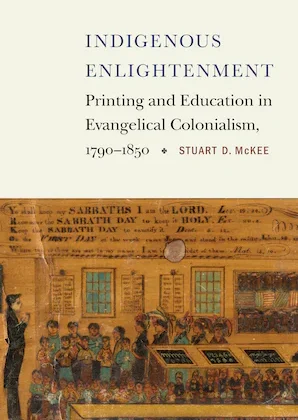

Stuart McKee is Associate Professor of Design at the University of San Francisco. This interview is based on his new book, Indigenous Enlightenment: Printing and Education in Evangelical Colonialism, 1790-1850 (University of Nebraska Press, 2023).
JF: What led you to write Indigenous Enlightenment?
SM: I began to research the book Indigenous Enlightenment after creating an atlas for exhibition at my school, the University of San Francisco, in 2010. The atlas, titled The Spread of Printing, presented a sequence of 108 maps that documented the dissemination of printing presses throughout the world between the fifteenth and nineteenth centuries. The atlas revealed that the majority of printing presses had been commissioned from England and the eastern seaboard of the United States, with London responsible for the export of presses into twenty-three colonial sites, including Antananarivo, Calcutta, Canton, Kathmandu, Montevideo, Sydney, Tranquebar, and Wellington. London, I came to learn, was also the center for the dissenting evangelical movement that prompted several missionary societies into action late in the eighteenth century. The founding members of those societies presumed that the world’s “heathen” peoples would welcome the revelation of Christian doctrine, once provided the initiative to read for themselves. I began to develop the book Indigenous Enlightenment to better understand the ways in which evangelical educators attempted to ameliorate the cultural assimilation of many different Indigenous communities by printing books in the Indigenous languages. In contradiction to the celebratory assessments that appeared throughout the popular evangelical periodicals of the early nineteenth century, the book reveals that the educators’ attempts to deliver devotional, secular, and vocational knowledge rarely elicited predictable results. The bulk of expatriate educators left home ill-equipped to manage an overseas publishing operation, and battled misguided prejudices about the intellectual capabilities of their indigenous students.
JF: In two sentences, what is the argument of Indigenous Enlightenment?
SM: The book Indigenous Enlightenment examines the ways in which the British and American enterprise to educate various groups of subject peoples by printing books in the Indigenous languages—rather than printing in English, or not printing at all—bolstered their propensity toward Western conceptions of enlightenment. The investigation unfolds as a series of case studies that investigates why different groups of subject people chose to affiliate with Protestant educators, as ambassadors of an ecumenical evangelism, so that both parties could learn to read, to write, and to print educational literature in the Indigenous language at hand.
JF: Why do we need to read Indigenous Enlightenment?
SM: Many Protestant educators quickly discovered that their teaching efforts languished without the means to publish books in the indigenous languages. The book Indigenous Enlightenment will illuminate the challenges that British and American educators faced, and the resources that they shared, while teaching indigenous children and adults to learn to read, to write, and especially to print the indigenous languages.
I have authored this book to engage a diverse readership of individuals with interest in three fields of history: the British and American evangelical impulse, the cultural heritage of indigenous peoples, and printing as colonial pedagogy. The book, which the University of Nebraska Press released on December 1, 2023, will be reaching readers at a time when developments pertaining to indigenous peoples’ cultural rights and political liberty have become internationally prominent.
JF: Why and when did you become an American historian?
SM: My academic training is not in the discipline of history, but in the fine arts. I studied painting and printmaking as an undergraduate student at Washington University in St. Louis from 1979–1983. The printmaking experience led to my greater interest in the history of printing and publishing, which then led me to study graphic design as a graduate student at the Yale University School of Art beginning in 1987. My studies at Yale sparked my interest in history, and provoked my special interest in understanding how design artifacts, including books, have contributed to the public’s perception of identity construction, maintenance, and performance among a diverse range of minority groups.
JF: What is your next project?
SM: During the 2020–2021 academic year, I began the process of laser-cutting the characters of a roman antiqua font from cherry wood planks. I have now cut more than 250 individual sorts for this font, including ligatures and kerning pairs. The font has allowed me to begin production on a series of large-format, hand-made prints that combine New Testament scripture from the King James Bible with nineteenth-century translations of the same text in different Native American languages, including Choctaw, Dakota, Osage, Ojibwe, and Seneca. Prompted by President Andrew Jackson’s enforcement of the Indian Removal Act in 1830, missionaries tested the ways in which printing might promote the indigenous Americans’ assimilation while sequestered within the newly formed Indian Territory and other independent reservations. By making these prints, I am hoping to gain insight into the procedures that missionaries used to impose Christianity and civilization upon different Native American nations.
JF: Thanks, Stuart!